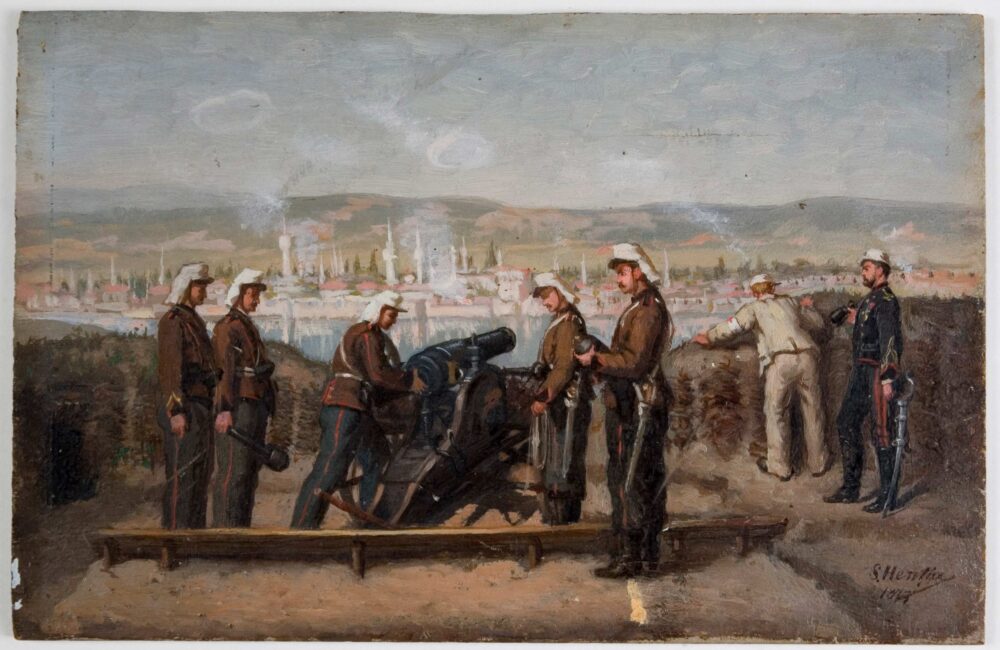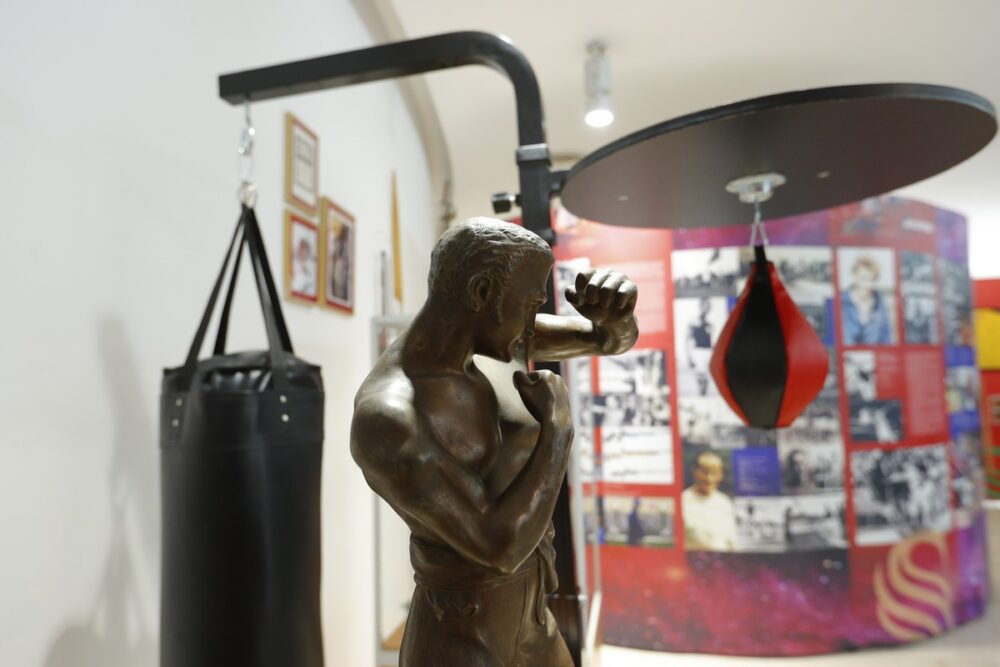Packed full of preserved medieval towns, fortified churches and castles, and Communist-era buildings, Romania and its capital city Bucharest are fertile grounds for cultural exhibitions that shine a light on the nation’s fascinating history.

Battery at Calafat (1877). Sava Hentia (1848–1904) (Photo: Oil on wood, 146 mm x 225 mm, MNIR, no. inv. 81342, Restoration: Andreea Teodorescu)
The southeastern European country is also known for its forested region of Transylvania, ringed by the Carpathian Mountains, which have provided inspiration for many artists down the ages. And together with its man-made landmarks, it all adds up to one of the continent’s most beguiling – if under-explored – destinations. If you’re planning to spend time in Bucharest or beyond, we’ve picked out 7 of the best museum exhibitions in Romania set to run over the coming months.
Around the Smârdan Attack
Among the defining episodes for modern Romanian history, the Russo-Turkish War (1877-1878) redrew borders and redistributed the poles of power in the Eastern European space, after which Serbia, Montenegro and Romania gained independence from the Ottoman Empire. As a tribute to the 185th anniversary of the birth of painter Nicolae Grigorescu, respectively 145 years since Romania’s emancipation from Ottoman rule, this exhibition focuses on one particular monumental work of the artist, “The Attack on Smârdan”. After an absence of more than 20 years and extensive restoration works, the painting is featured along with several other iconographic testimonies from the War of Independence.
National Museum of Romanian History, Bucharest / Through February 2024
Orientation by the stars: In Search of the Lost Road

(Photo: “Dimitrie Gusti” National Village Museum)
Designed to measure the angle between an astronomical object and the horizon for the purposes of celestial navigation, the instruments known as ‘sextants’ along with the knowledge necessary to use them are critical tools for astronomers the world over. This exhibition includes over 100 objects utilised in orientation at sea, but also maps with the celestial vault to identify the 57 stars used in astronomical navigation. There are also elements of a ship’s equipment: wheelhouses, locches, navigation lights, lifebuoys and many other instruments.
“Dimitrie Gusti” National Village Museum, Bucharest / Through 16 October 2023
Artillery, Armoured Vehicles, Aircraft and Naval Weaponry
Established in 1923 by the Romanian King Ferdinand I, this museum, housed in a century-old building close to Bucharest North Railway Station, features a rich collection of uniforms and weapons. Covering over 2,000 square metres, this permanent exhibition displays more than 180 artefacts, many rare or unique in Europe and across the world. Among them are Krupp-type cannons used in the Independence War, and vehicles from the Great War, Second World War and Communist Period. Other notable exhibits featured include two Škoda railway heavy howitzers captured by the Romanian army in 1919.
The King Ferdinand I National Military Museum, Bucharest / Permanent
The History of Currency Circulation in Romania

(Photo: National Bank of Romania Museum)
Chronologically displayed in ten showcases, this exhibition recreates Romanian history from the perspective of currency circulation. Beginning with the presentation of coins issued in Histria, a city on the Western shore of the Black Sea, which had started striking silver didrachms in 480 BC – making them the first coins ever to be minted on the territory of present-day Romania – the exhibition features a large range of Romanian money types spanning from Antiquity to the 19th century. It also includes fractional coins (obols, hemiobols, trihemiobols), as well as exhibits showcasing coinage from Callatis and Tomis, the other two Greek cities on the Dobruja seacoast.
National Bank of Romania Museum, Bucharest / Permanent
Colors in Nature
Just as man gives social meanings to colours, in nature they can carry various meanings such as those of danger, age, sex, dominance, food or toxicity. This exhibition addresses multiple perspectives on nature, chemistry and physics along the visible colour spectrum, giving visitors the opportunity to admire and compare different shades of colour formed as natural phenomena. Among the diverse pieces on display are underground mineral pigments, mineral-organic structures, the glittering of rare butterfly wings, plants, exotic bird iridescences and chromatic aberrations of albino vertebrate specimens.
Muzeul Național Brukenthal, Sibiu / Through 31 March 2024
Romanian Sports History

(Photo: Muzeul Sportului)
From the appearance of the first sports activities in the country to the development of numerous disciplines, this exhibition gives visitors the chance to foray into the history of Romanian sporting endeavours. Through an assortment of images, text, objects such as medals, trophies and sports equipment, it chronicles the history of the disciplines that have helped put Romania on the sporting map. Highlights include the collective passport with which the Romanian football team participated in the first World Cup in Uruguay in 1930; the sword with which Mihai Covaliu won gold at the Sydney Olympics in 2000; and Olympic medal winner Aurel Vernescu’s kayak.
Muzeul Sportului, Bucharest / Permanent
Dialogue
Part of the ongoing European Days of Jewish Culture project which first kicked off in 2021, this exhibition addresses the idea of ‘dialogue’ in Jewish culture through five different points of view: dialogue between generations, between texts, between Jews within the community, between Jewish culture and other cultures, and between Judaism and other faiths. In doing so, it explores how Jewish traditions are being passed down to the new generations. Featured are a wide range of photographs, illustrated manuscripts of religious and philosophical texts, letters, press articles and posters.
Muzeon – Jewish History Museum, Cluj-Napoca / Through 10 October 2023